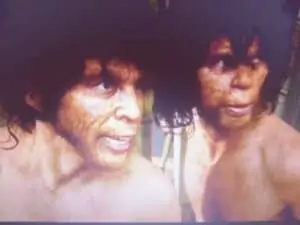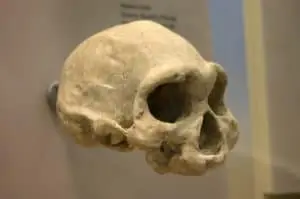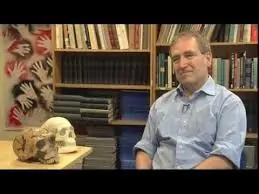Asia Erectus fossils emerge
The Chinese anthropologists have been stridently arguing for decades for multiregional origins. Wu Xinzi and others, have argued for continuity from Homo erectus to modern East Asians. Western anthropologists influenced by woke and disdainful of human variation, have largely ignored their evidence.
There have been a few exceptions, namely Chris Stringer, Rainer Grun and most certainly Maria Martinon-Torres. But for the most part, the diehard Out of Africa crowd has shunned the Chinese, even when the cranial and post-cranial evidence is staring them right in the face.
Here we present the two fossils that offer the most powerful evidence of separation from Homo erectus in Asia and Homo ergaster in Africa, and for regional continuity from Asian erectus to modern day Asians – Hexian cranium and the Penghu jawbone.
African Ergaster separate from Asia Erectus?
The Smithsonian provides some background on how the fossil was originally found.
 LiveScience reports that a fossilized jawbone discovered in a fishing net off the western coast of Taiwan may belong to a previously unknown form of archaic human that once dwelled in Asia. The lower right mandible, complete with a short row of thick teeth, is thought to be from a hominin that lived between 10,000 and 190,000 years ago.
LiveScience reports that a fossilized jawbone discovered in a fishing net off the western coast of Taiwan may belong to a previously unknown form of archaic human that once dwelled in Asia. The lower right mandible, complete with a short row of thick teeth, is thought to be from a hominin that lived between 10,000 and 190,000 years ago.
Scientists who recently published a study of the fossil, dubbed Penghu 1, noted a resemblance to a 400,000-year-old specimen discovered some 600 miles from where the jawbone was found. This led them to wonder if the two fossils may represent an unclassified human species.
Additionally:
The fossil was discovered in the Penghu Channel, which was part of the China mainland during the last ice age. The anonymous fisherman then sold it to an antique shop, and it was eventually obtained by Taiwan’s National Museum of Natural Sciences. No word on what kind of payout a prehistoric fossil got him, but it is likely to be the most valuable catch of his career—at least anthropologically.
From the journal Nature,
The first archaic Homo from Taiwan
 Recent studies of an increasing number of hominin fossils highlight regional and chronological diversities of archaic Homo in the Pleistocene of eastern Asia. However, such a realization is still based on limited geographical occurrences mainly from Indonesia, China and Russian Altai. Here we describe a newly discovered archaic Homo mandible from Taiwan (Penghu 1), which further increases the diversity of Pleistocene Asian hominins.
Recent studies of an increasing number of hominin fossils highlight regional and chronological diversities of archaic Homo in the Pleistocene of eastern Asia. However, such a realization is still based on limited geographical occurrences mainly from Indonesia, China and Russian Altai. Here we describe a newly discovered archaic Homo mandible from Taiwan (Penghu 1), which further increases the diversity of Pleistocene Asian hominins.
Additionally:
Such patterns of geographic trait distribution cannot be simply explained by clinal geographic variation of Homo erectus between northern China and Java, and suggests survival of multiple evolutionary lineages among archaic hominins before the arrival of modern humans in the region.
From the Introduction:
 The new hominin mandible we describe here contributes to fill this geographic gap of the Asian fossil record. Penghu 1 Repository, National Museum of Natural Science, Taichung) that was dredged by a fishing net from the −60 to −120 m deep Penghu submarine channel, 25 km off the western shore of Taiwan, together with other vertebrate fossils known as the terminal Middle/Late Pleistocene ‘Penghu fauna…
The new hominin mandible we describe here contributes to fill this geographic gap of the Asian fossil record. Penghu 1 Repository, National Museum of Natural Science, Taichung) that was dredged by a fishing net from the −60 to −120 m deep Penghu submarine channel, 25 km off the western shore of Taiwan, together with other vertebrate fossils known as the terminal Middle/Late Pleistocene ‘Penghu fauna…
Chris Stringer says it’s a magnificent find
Natural History Museum’s Chris Stringer is quoted at Australia ABC.au, 2012:
Chris Stringer of the Natural History Museum notes Penghu 1’s “short and wide” jawbone with its “large teeth,” all raise “interesting questions about its classification.”
Stringer says that in some ways the fossil is more primitive looking than the well-known ‘Peking Man’ remains from Zhoukoudian, China, yet it also has certain features in common with the archaic human Homo heidelbergensis, as well as Homo erectusand even Denisovans.
“This enigmatic fossil is difficult to classify,” says Stringer, “but it highlights the growing and not unexpected evidence of human diversity in the Far East, with the apparent coexistence of different lineages in the region prior to, and perhaps even contemporary with, the arrival of modern humans some 55,000 years ago.”
